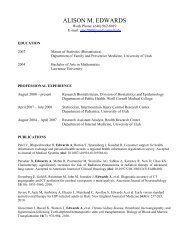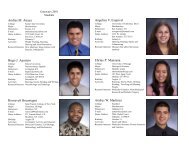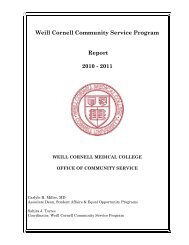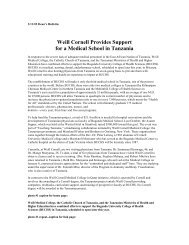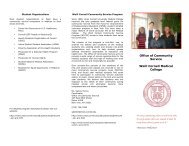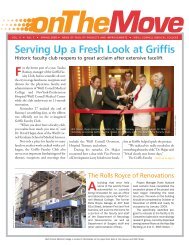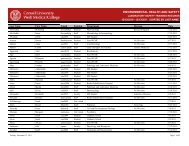Weillcornellmedicine - Weill Medical College - Cornell University
Weillcornellmedicine - Weill Medical College - Cornell University
Weillcornellmedicine - Weill Medical College - Cornell University
Create successful ePaper yourself
Turn your PDF publications into a flip-book with our unique Google optimized e-Paper software.
Back in the U.S., as a fellow at the Barrow<br />
Neurological Institute in Phoenix, Bernardo continued<br />
to develop the technology. He created a 3-D<br />
surgical simulator, the Interactive Virtual Dissection,<br />
which allows surgeons to improve visualspatial<br />
skills by simulating surgery—doing the<br />
drilling, clipping, and cutting in virtual reality on<br />
a computer that shows actual cadaver images.<br />
Using the program, surgeons choose a route and<br />
instruments, then practice the procedures. Bernardo<br />
is now at work adding force feedback, so the<br />
tactile sensations of surgery will be replicated as<br />
well. While the hardness and roundness of the<br />
spine and nerve tissue are easy enough to approximate,<br />
he says, brain tissue is more difficult to replicate<br />
on a computer program, due to its elasticity.<br />
On the screen before him, Bernardo demonstrates<br />
how the 3-D technology can also transform<br />
pre-operative planning, as he weighs several<br />
options for surgical approaches to removing a<br />
tumor. By importing data from CT scans, MRIs,<br />
and ultrasounds, the program creates a replica of<br />
the patient in three dimensions. Bernardo investigates<br />
the skull from every possible angle, zooming<br />
in and out. He slices the plane of the skull by<br />
increments, seeing the exact contours of the lesion<br />
and its relation to the bone and vascular structures.<br />
He resects the tumor, which enables him to<br />
see where any vessels or nerves lie within it.<br />
Then, Bernardo turns the patient’s head into a<br />
surgical position and demonstrates the conventional<br />
approach through the top of the head—a<br />
pathway, he shows, that would make complete<br />
removal of the tumor impossible. He turns the<br />
head another way, and demonstrates the much<br />
shorter orbitozygomatic path. The difference is<br />
striking. All options still not exhausted, he turns<br />
the patient again and tries another approach,<br />
known as a subtemporal with anterior petrosectomy.<br />
It too reveals complete access to the tumor,<br />
but turns out to have an even shorter trajectory.<br />
It’s the preferred route. “I used to have to picture<br />
the dimensions in my head just by looking at the<br />
flat image on the lightbox,” he says. “Now I can<br />
turn the image around, put the head into surgical<br />
position, look at it from various approaches, and<br />
see what kinds of structures I’m going to<br />
encounter. You can completely extrapolate the<br />
depth of the surgical field, see which route takes<br />
you closer. It makes everything safer for the<br />
patient.”<br />
For now, the best way for surgeons to use this<br />
knowledge is simply to memorize it. In this case,<br />
the surgeon knows he will resect the tumor from<br />
top to bottom rather easily and that the task will<br />
grow more difficult toward the bottom, where the<br />
lesion rests on the carotid artery; by reaching<br />
beneath each side of the artery, however, he’ll be<br />
able to remove it entirely. But Bernardo hopes<br />
there may soon be another way to use the data.<br />
The 3-D image could be viewed through a visor<br />
that allows surgeons to switch between it and the<br />
microscopic view of the actual surgical field. In<br />
fact, Bernardo is at work on just such a device.<br />
The laboratory was in transition last fall, moving<br />
from one space to another during a building<br />
renovation. In its temporary quarters, it doesn’t<br />
look so high-tech. It contains two workstations,<br />
surgical bays that—aside from issues of sterility—<br />
look just as they would in an OR. On the microscope,<br />
Dr. Bernardo has mounted four video and<br />
two still cameras to record dissections. In a container<br />
on the surgical tray lie two pieces of skull, a<br />
visual representation of a two-piece orbitozygomatic<br />
craniotomy, one of the most useful skeletal<br />
gateways for skull-base surgery.<br />
When each new fellow arrives at the lab,<br />
Bernardo offers this surprising piece of advice:<br />
Don’t study too much. “It sounds paradoxical,<br />
and they look at me strangely,” he says. “But<br />
when you read too many papers you get a bias,<br />
and then when you do dissection, you’ll do the<br />
same dissection that’s been done before.” So for<br />
the months of their fellowship, he tells them, give<br />
your brain the freedom to explore. “At the end of<br />
the day, 98 percent of the time, you’ll end up<br />
doing what’s been done before,” he says. “But if<br />
you do this experiment, you’ve got that 2 percent<br />
chance to do something nobody’s ever done.” •<br />
For more information about the Microneurosurgery<br />
Skull Base Laboratory, go to:<br />
www.cornellneurosurgery.com/skullbasesurgery<br />
‘You can completelyextrapolate<br />
the depth<br />
of the surgical<br />
field, see which<br />
route takes you<br />
closer. It makes<br />
everything safer<br />
for the patient.’<br />
Virtual vision: Surgeons can<br />
simulate procedures using<br />
images taken of cadavers.<br />
WINTER 2008/09 33




